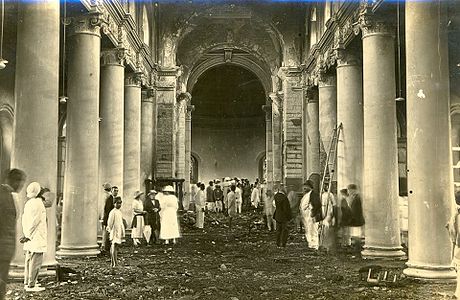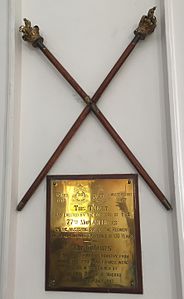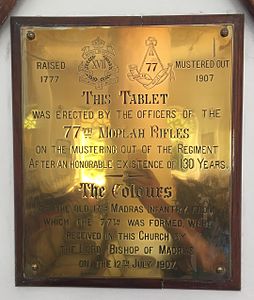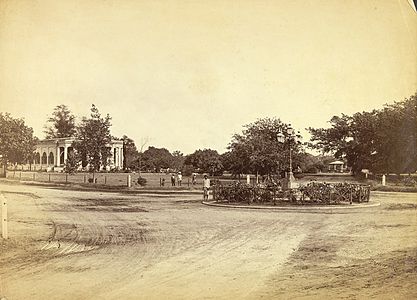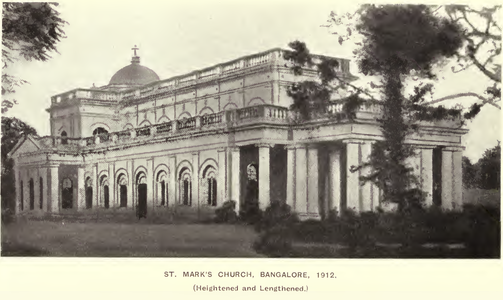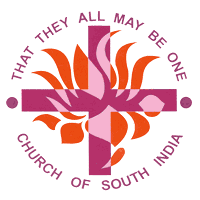
The Church of South India (CSI) is a united Protestant Church in India. It is the result of union of a number of Protestant denominations in South India that occurred after the independence of India.
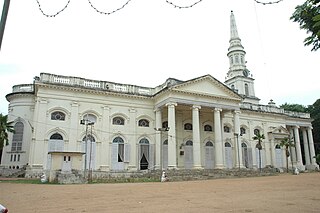
St. George's Cathedral is a Church of South India cathedral in Chennai, India. The cathedral was built in 1815. St. George's occupies an important place in the history of Christianity in India, as the Church of South India was inaugurated here on 27 September 1947. It marked the breaking down of ecclesiastical barriers between Protestants of various traditions.

Bangalore Fort began in 1537 as a mud fort. The builder was Kempe Gowda I, a vassal of the Vijaynagar Empire and the founder of Bangalore. Hyder Ali in 1761 replaced the mud fort with a stone fort and it was further improved by his son Tipu Sultan in the late 18th century. It was damaged during an Anglo-Mysore war in 1791. It still remains a good example of 18th-century military fortification. The army of the British East India Company, led by Lord Cornwallis on 21 March 1791 captured the fort in the siege of Bangalore during the Third Mysore War (1790–1792). At the time the fort was a stronghold for Tipu Sultan. Today, the fort's Delhi gate, on Krishnarajendra Road, and two bastions are the primary remains of the fort. A marble plaque commemorates the spot where the British breached fort's wall, leading to its capture. The old fort area also includes Tipu Sultan's Summer Palace, and his armoury. The fort has provided the setting for the treasure hunt in the book Riddle of the Seventh Stone.
Bangalore (Bengaluru), the capital of Karnataka state, India, reflects its multireligious and cosmopolitan character by its more than 1000 temples, 400 mosques, 100 churches, 40 Jain derasars, three Sikh gurdwaras, two Buddhist viharas and one Parsi fire temple located in an area of 741 km2 of the metropolis. The religious places are further represented to include the few members of the Jewish community who are making their presence known through the Chabad that they propose to establish in Bengaluru and the fairly large number of the Baháʼí Faith whose presence is registered with a society called the Baháʼí Centre. In the demographically diverse, major economic hub and India's fastest-growing major metropolis of Bengaluru, the number of religious places of each religion reported reflects growth in proportion to the population growth. According to the 2001 census of India, 79.37% of Bangalore's population is Hindu, roughly the same as the national average. Muslims comprise 13.37% of the population, which again is roughly the same as the national average, while Christians and Jains account for 5.79% and 1.05% of the population, respectively, double that of their national averages. Anglo-Indians also form a substantial group within the city.
The 77th Moplah Rifles were an infantry regiment of the British Indian Army. They could trace their origins to 1777, when they were raised as the 17th Carnatic Battalion.

CSI-Holy Trinity Church is a church under the auspices of the Protestant Church of South India, a uniting Church. It is located in the Bolarum locality of Secunderabad Cantonment.

CSI-St. George's Church is the oldest church in the city of Hyderabad, India. It was built in 1844 AD by the Church Missionary Society (CMS) and has been unionized in 1947 into the Church of South India, a uniting Church.

Holy Trinity Church, located at Trinity circle at the east end of the MG Road, is a major landmark in Bangalore. It was built in 1851, for the British Regiment stationed in Bangalore. Built in the English Renaissance style, the church can accommodate 700 people and is regarded as the largest "military" church in southern India. It has a congregation of over 450 families

The CSI Immanuel Cathedral, Ernakulam, under the Diocese of Cochin of the Church of south India, was dedicated more than 103 years ago.

The Diocese of Madras is a diocese of Church of South India in Tamil Nadu state of India.The diocese is one among the 22 dioceses of Church of South India.
The Karnataka Central Diocese is one of the twenty-two dioceses of the Church of South India covering the central part of Karnataka.
St. Andrew's Church, consecrated in 1866, is a Presbyterian church, located on Cubbon Road, Bangalore. Initially knows as St. Andrews's Kirk, it was a Church of Scotland church till 1959 when it became part of the Karnataka Central Diocese of the Church of South India. The church is named after Saint Andrew, the patron saint of Scotland. St Andrew's Church celebrated its 150 years anniversary on 20 November 2014.
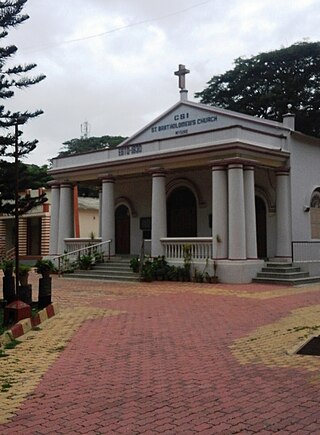
St. Bartholomew's Church is an Anglican church, built by the Madras Government for the East India Company troops stationed in Kingdom of Mysore and is located in Lashkar Mohalla, on the Nilgiri Road, near the noisy Mysore sub-urban bus stand in Mysore City. The church grounds was consecrated on 29 November 1830 by Bishop Turner of Calcutta, (p. 327) and the building was completed in 1832. The church is named after Saint Bartholomew, one of the 12 apostles of Jesus Christ, and is said to have visited India in the first century AD, and preached the Christian gospel in the Kalyan, Thane and Raigad regions of present-day Maharashtra.
St. Paul's Church is located in the corner of Old Poor House Road, and Bowring Hospital Road, next to the Bowring and Lady Curzon Hospital, Bangalore Cantonment, India. St. Paul's has the distinction of being the very first Tamil Anglican Church in the erstwhile Mysore State. St. Paul's celebrated its 175th anniversary in May 2014. Like most old churches of Bangalore, the congregation of St. Paul's is spread all across Bangalore.
St. John's Church is located in St. John's Hill, Cleveland Town, Bangalore Cantonment, India, in between Promenade Road and St. John's Church Road. The church is the fourth oldest Protestant church in the city, with a distinct red edifice and towering steeple, rising out of the leafy surroundings. The church is dedicated to St. John the Evangelist.
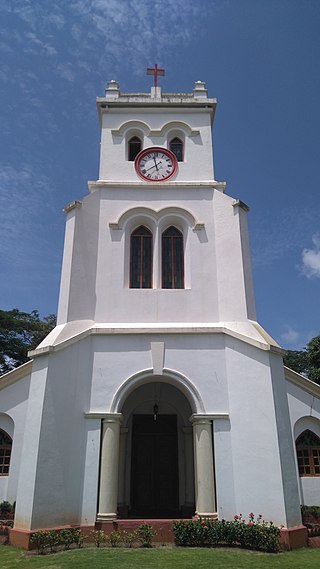
St. Paul's Church is an Anglican church in Mangalore, India.
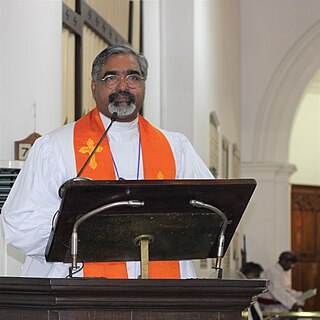
A. C. Solomon Raj is the seventh successor of Frank Whittaker and eighth Bishop in Medak of the Protestant Church of South India Society and shepherds the Diocese from the Cathedra of the Bishop housed in the CSI-Medak Cathedral in Medak Town, Telangana, India. On 12 October 2016, the Church of South India Synod headquartered in Chennai, appointed Solomon Raj to assume the ecclesiastical Office of the Bishopric of Medak and was consecrated the next day on 13 October 2016 at the CSI-St. George's Cathedral, Chennai, ending four years of sede vacante in the Diocese of Medak which was without a bishop during the intervening period of 2012–2016.
Samuel Thomas Pettigrew (1827–1889) was an East India Company chaplain, who served in Rangoon, Kamptee, Bangalore, Ootacamund and Trivandrum, and is credited with establishing the Bishop Cotton's School and Cathedral High School in Bangalore.
Bishop Bunyan Joseph was the first and only elected Bishop - in - Anantapur-Kurnool Diocese who was consecrated on 27 September 1947 and was among the 15 inaugural Bishops when the Church of South India was inaugurated at the CSI-St. George's Cathedral, Chennai. He was presented for consecration by The Venerable F. F. Gladstone and Canon T. Sithers. to the Presiding Bishop Cherakarottu Korula Jacob, who as the first Moderator, consecrated Bunyan Joseph.




